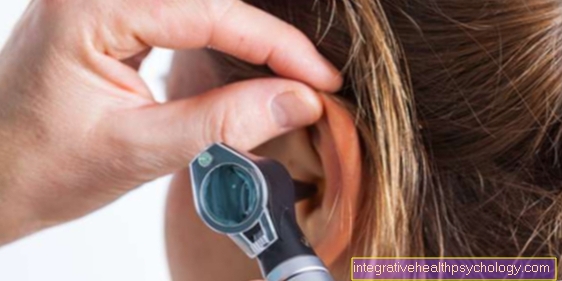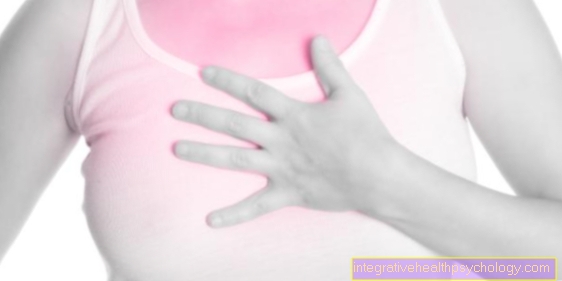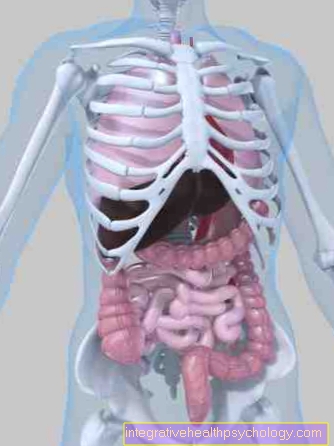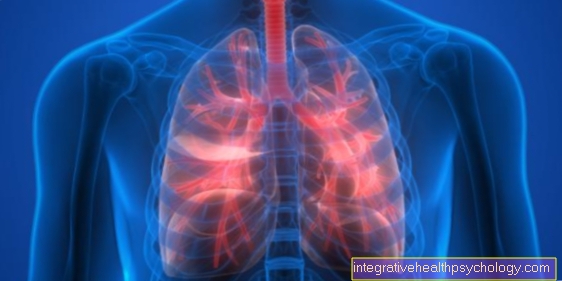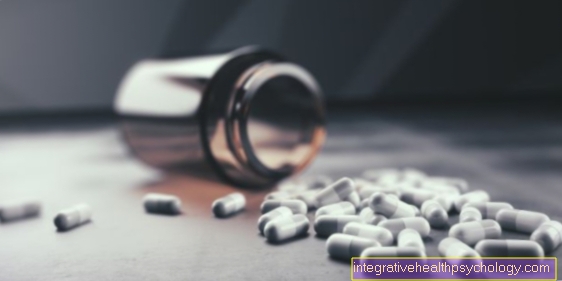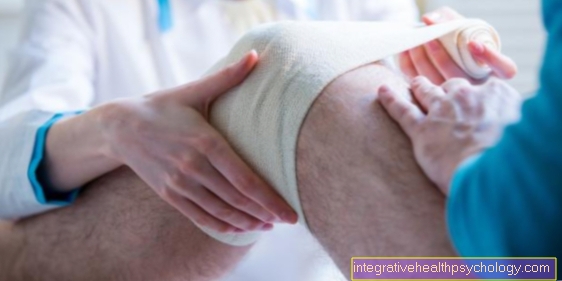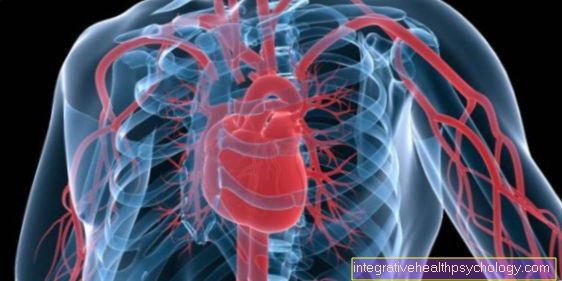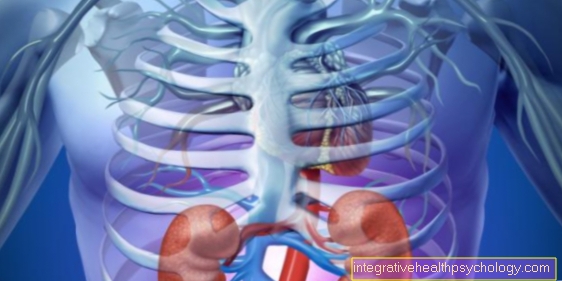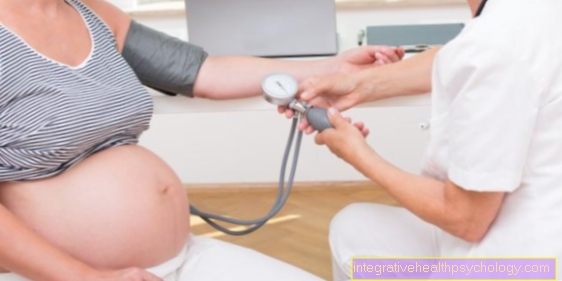Pseudomembranous colitis
definition
Pseudomembranous colitis is a serious inflammation of the lining of the colon. This is caused by the bacterium Clostridium difficile caused and usually occurs in connection with a previous antibiotic therapy.
If left untreated, pseudomembranous colitis can be fatal. The main symptom of this condition is massive watery diarrhea, which may contain blood.

Epidemiology / frequency
Exact figures on the contamination rate with Clostridium difficile (pseudomembranous colitis) are not known. It is estimated that around 3% of all adults and around 50% of infants carry Clostridium difficile in their intestines.
However, there were no signs of clinical symptoms. However, the fact is that the bacterium is found in most hospitals. The risk for the patient of coming into contact with this pathogen is correspondingly high. Patients with long hospital stays, broad antibiotic therapy or multimorbid patients are particularly at risk.
At the same time, they are also much more at risk of actually developing pseudomembranous colitis.
Cause pseudomembranous colitis
The bacterium Clostridium difficile of pseudomembranous colitis is a gram-positive anaerobic bacterium and not a natural inhabitant of the human intestinal mucosa. However, the bacterium is very widespread in hospitals and is easily transmitted to patients there through objects or staff.
What activates the sleeping bacterium in the intestine is still not sufficiently known.
Antibiotics are seen as one of the most important triggers. The explanation for this is the natural protection of the intestinal flora, which is disturbed by antibiotic therapy.
Thus the bacterium Clostridium difficile has the possibility to multiply and attack the intestines. This leads to antibiotic-associated colitis, which is much easier to treat than the actual pseudomembranous colitis.
(Read more on the topic: Abdominal pain from antibiotics)
If the bacterium is activated in the intestine, it can multiply very quickly and form two different toxins. Toxin A is a cytotoxin that significantly increases electrolyte excretion and is therefore responsible for watery diarrhea. Toxin B is a cell-damaging poison that attacks the intestinal wall and leads to massive inflammation there. In addition, parts of the intestinal wall are thickened because the fibrin and exudate together form a membrane on the mucous membranes. This happens in the context of inflammation and explains the name of pseudomembranous colitis.
Symptoms of pseudomembranous colitis
The symptoms of pseudomembranous colitis range from mild diarrhea, which limit themselves after a while, to a severe feeling of illness with massive watery-bloody diarrhea and fever.
In addition, those affected complain of severe abdominal pain and abdominal cramps. However, the symptoms are not directly related to the severity of the disease. The clinical picture should therefore not be used exclusively to assess the severity.
Due to the damage to the intestine, a rupture of the intestine may occur ( perforation) who have peritonitis (Peritonitis) can result. If the disease is so advanced it is fatal if left untreated.
Can pseudomembranous colitis be possible without diarrhea?
Pseudomembranous colitis without diarrhea is very rare. Diarrhea is actually the main symptom of the disease. Without the presence of diarrhea, the diagnosis is much more difficult. In rare cases, pseudomembranous colitis can only manifest itself through abdominal pain.
Is Pseudomembranous Colitis Contagious?
Pseudomembranous colitis is not contagious. It is caused by certain bacteria in the intestine, which, however, only play a role in patients whose intestinal flora (all the microorganisms that colonize the intestine) have been significantly weakened by taking antibiotics. Infection is therefore not possible.
Duration
The duration of pseudomembranous colitis depends largely on the severity of the disease and the therapy. In the worst case scenario, the disease can lead to death in patients who are seriously ill and are not receiving any therapy. If treatment is carried out by discontinuing the offending antibiotic and drug therapy with another antibiotic, the symptoms (diarrhea, abdominal pain) usually subside relatively quickly, depending on the severity of the disease.
diagnosis
The pseudomembranous coatings can be seen endoscopically in the rectum as yellow deposits (pseudomembranous colitis). The clinic and anamnesis also play an important role. The question of a previous antibiotic therapy is a particularly important indication of the diagnosis.
The symptoms of pseudomembranous colitis can, however, set in immediately with antibiotic therapy or up to 4 weeks after therapy.
It should be urgently between one "Real" pseudomembranous colitis and one Antibiotic Associated Colitis differentiated in order to be able to choose the right therapy. Proof of infestation with active Clostridium difficile is the Detection of toxins in stool and a chair culture.
Histological examination
A histological, i.e. histological, examination is required for the diagnosis of many diseases. This is not the case with pseudomembranous colitis. The diagnosis is made here by clinical information (diarrhea, antibiotic intake) and possibly imaging measures (abdominal ultrasound, computed tomography, magnetic resonance imaging) and, above all, by a colonoscopy. It is also possible to detect the causative bacterium in the stool.
therapy
If the pseudomembranous colitis is related to antibiotic therapy, it should be discontinued immediately. In some cases this is enough.
The natural intestinal flora can develop again after the therapy is discontinued and curb the spread of Clostridium difficile. In severe cases, fluids and electrolytes are usually essential. This often has to be done parenterally via the vein, as the patients cannot absorb any fluid due to the massive diarrhea. Medication for diarrhea should be avoided if possible. The hygienic measures are particularly important in order to keep the risk of infection as low as possible.
Since the bacterium forms spores, the usual disinfectants are ineffective. For this reason, affected patients should be isolated. Nursing staff should not do without careful hand washing, as hand disinfectants cannot attack spores either. If the above-mentioned therapy for pseudomembranous colitis is insufficient, treatment with metronidazole or vancomycin is carried out for 7 days.
Sufficient antibiotic treatment is important, for at least 3 days after the diarrhea has subsided. In this way recurrences or resistance can be avoided. In 20% of the cases there is a relapse after the end of therapy. The reason for this is that only active pathogens are killed by the antibiotic. But not the spores, i.e. sleeping, inactive bacteria.These can become active after antibiotic therapy and find excellent conditions for growth in the still affected intestine.
Such a relapse can be treated relatively easily with metronidazole or vancomycin. In order to avoid relapses, yeast preparations are used after the end of therapy. These help the intestine to regenerate more quickly and restore it to its normal state.
Stool transplant
A stool transplant is the transfer of stool or the bacteria contained in stool from a healthy donor into a patient's bowel. The stool transplant pursues the goal of being irreparable restore damaged intestinal flora of the patient and thus to create or at least promote a physiological, i.e. healthy microbiome.
Stool transplants are to date not officially approved as a form of therapy, but count as an "individual healing attempt" if indicated accordingly. The only common use, however, is pseudomembranous colitis.
Performing a stool transplant begins with the Preparation of the stool from a healthy donor. For this purpose, the donor stool is diluted with a physiological saline solution and then filtered, whereby it is cleaned of superfluous components such as the indigestible fiber and dead bacteria.
The suspension produced in this way is then in most cases via a previously means Endoscopy (Reflection) placed probe in the Duodenum of the patient.
Another possibility is introducing the bacteria into the Large intestine by means of Colonoscopy (Colonoscopy).
prophylaxis
The most important thing to protect against pseudomembranous colitis is a healthy intestinal flora. This offers natural protection against attacking bacteria. Probiotic preparations can be used for this. These support a healthy intestinal flora, even under difficult conditions. Studies have shown that a regular intake of yogurt improves the intestinal flora and thus prevents the occurrence of pseudomembranous colitis.
forecast
The Prognosis of pseudomembranous colitis strongly depends on the severity of the disease and the previous illnesses of the patient. Since in most cases sick or multimorbid patients are already affected, the mortality rate is higher in these patient groups.
Especially patients who are dependent on antibiotic therapy can get big problems from pseudomembranous colitis. The reason for this is the fact that the most important and sometimes only measure is to stop antibiotic therapy.
However, this is not possible in some patients due to the actual disease. There is a high mortality rate in this group of patients. However, if it is possible to stop antibiotic therapy without any problems, then it can Clostridium difficile can be treated relatively easily. Nevertheless, the high risk of infection is a major risk in hospitals and should be considered when contacting patients.
Can Adequate Diet Prevent Pseudomembranous Colitis?
Pseudomembranous colitis is caused by antibiotics. Diet plays no role in the development of the disease. In the presence of pseudomembranous colitis, discontinuation of the triggering antibiotic and drug therapy with another antibiotic are particularly important. The type of diet does not play an important role in the treatment of the disease. In very severe cases, parenteral nutrition may be necessary from time to time. This means that the patient does not eat anything himself, but the nutrients are supplied to him by means of infusions through the vein. This happens during inpatient hospital treatment.

